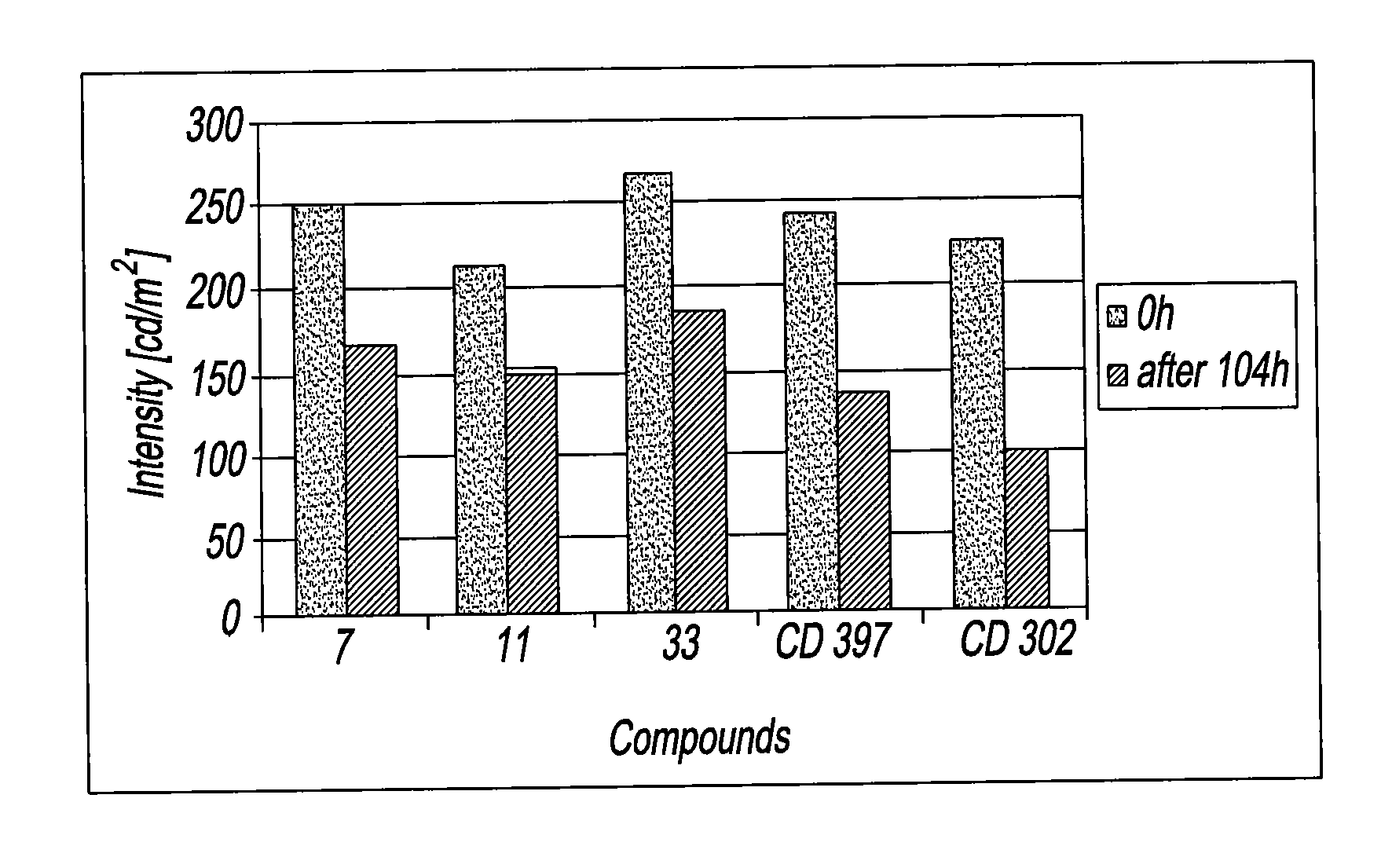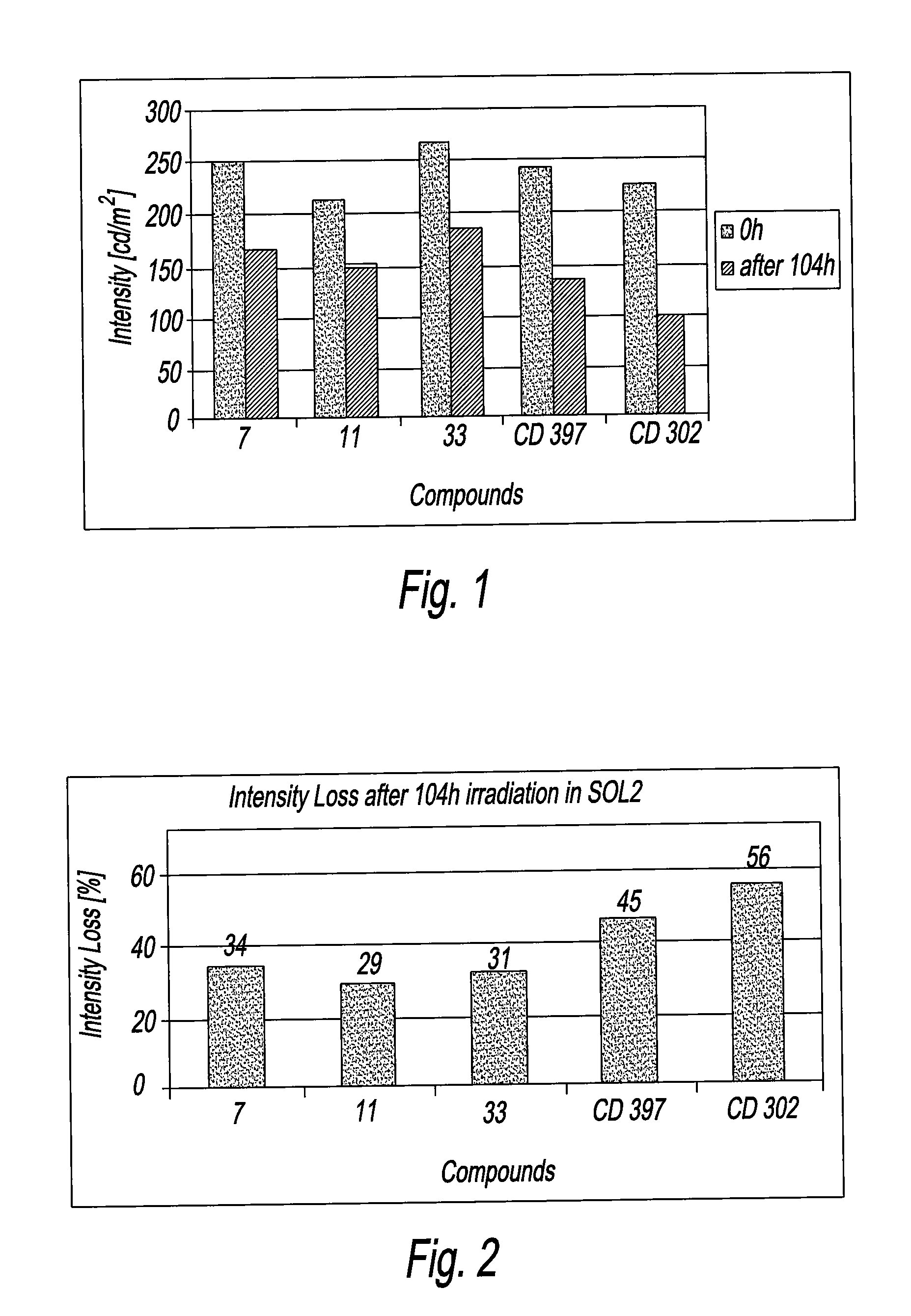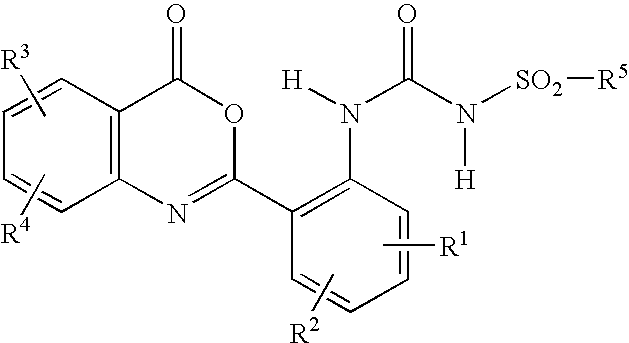Organic fluorescent sulfonyl ureido benzoxazinone pigments
a technology pigment, which is applied in the field of fluorescent sulfonyl ureido benzoxazinone pigments, can solve the problems of large amount of non-environmental friendly waste, and the inability to easily recycle pyridine reactant, etc., and achieves the purity reduction effect of benzoxazinone compounds, high yield and high purity
- Summary
- Abstract
- Description
- Claims
- Application Information
AI Technical Summary
Benefits of technology
Problems solved by technology
Method used
Image
Examples
example 1
Preparation of 1-(para-toluenesulfonyl)-3-[2-(4-oxo-4H-benzo[d]-[1,3]oxazine-2-yl)-phenyl]urea
[0066]In accordance with the present disclosure, 1-(para-toluenesulfonyl)-3-[2-(4-oxo-4H-benzo[d][1,3]oxazine-2-yl)-phenyl]urea, also named 1-(4-methylphenylsulfonyl)-3-[2-(4-oxo-4H-benzo[d][1,3]oxazine-2-yl)-phenyl]urea, where R1, R2, R3 and R4 are each hydrogen, and R5 is 4-methylphenyl, was prepared according to the following procedure: A 250 mL three-neck bottle was charged at room temperature with anthranoylanthranilic acid (0.05 mol) and 100 mL methyl ethyl ketone. Para-toluenesulfonyl isocyanate (0.05 mol) was then added, with stirring, and the reaction mixture was heated under reflux at about 80° C. for about 4 hours. Thereafter, the resulting suspension was cooled to about 40° C., and acetic anhydride (40 mL) was added. The resulting mixture was heated for an additional 3 hours. After cooling to about 10° C., the precipitate was filtered under suction, washed with acetone, and drie...
example 2
Preparation of 1-(phenylsulfonyl)-3-[2-(4-oxo-4H-benzo[d]-[1,3]oxazine-2-yl)-phenyl]urea
[0067]In accordance with the present disclosure, 1-(phenylsulfonyl)-3-[2-(4-oxo-4H-benzo[d]-[1,3]oxazine-2-yl)-phenyl]urea, where R1, R2, R3 and R4 are each hydrogen, and R5 is phenyl, was prepared in the same manner as described in Example 1, above. Yields were between 70%-85%. The Emission (fluorescence) maximum of the resultant powder was 528 nm. The excitation maximum was 380 nm. Differential Thermal Analysis showed the endothermic peak (melting point) at about 222° C. Intensity of fluorescence of the powder was 320 cd / m2, as measured with a Minolta luminance meter under 365 nm excitation. Solubility of the powder in 2-butanone was less than 0.5% at room temperature.
example 3
Preparation of 1-(2-methylphenylsulfonyl)-3-[2-(4-oxo-4H-benzo[d]-[1,3]oxazine-2-yl)-phenyl]urea
[0068]In accordance with the present disclosure, 1-(2-methylphenylsulfonyl)-3-[2-(4-oxo-4H-benzo[d]-[1,3]oxazine-2-yl)-phenyl]urea, where R1, R2, R3 and R4 are each hydrogen, and R5 is 2-methylphenyl, was prepared in the same manner as described in Example 1, above. Yields were between 70%-85%. The Emission (fluorescence) maximum of the resultant powder was 530 nm. The excitation maximum was 380 nm. Differential Thermal Analysis showed the endothermic peak (melting point) at about 207° C. Intensity of fluorescence of the powder was 260 cd / M2, as measured with a Minolta luminance meter under 365 nm excitation. Solubility of the powder in 2-butanone was less than 1% at room temperature.
PUM
| Property | Measurement | Unit |
|---|---|---|
| wavelength | aaaaa | aaaaa |
| wavelength | aaaaa | aaaaa |
| pressure | aaaaa | aaaaa |
Abstract
Description
Claims
Application Information
 Login to View More
Login to View More - R&D
- Intellectual Property
- Life Sciences
- Materials
- Tech Scout
- Unparalleled Data Quality
- Higher Quality Content
- 60% Fewer Hallucinations
Browse by: Latest US Patents, China's latest patents, Technical Efficacy Thesaurus, Application Domain, Technology Topic, Popular Technical Reports.
© 2025 PatSnap. All rights reserved.Legal|Privacy policy|Modern Slavery Act Transparency Statement|Sitemap|About US| Contact US: help@patsnap.com



